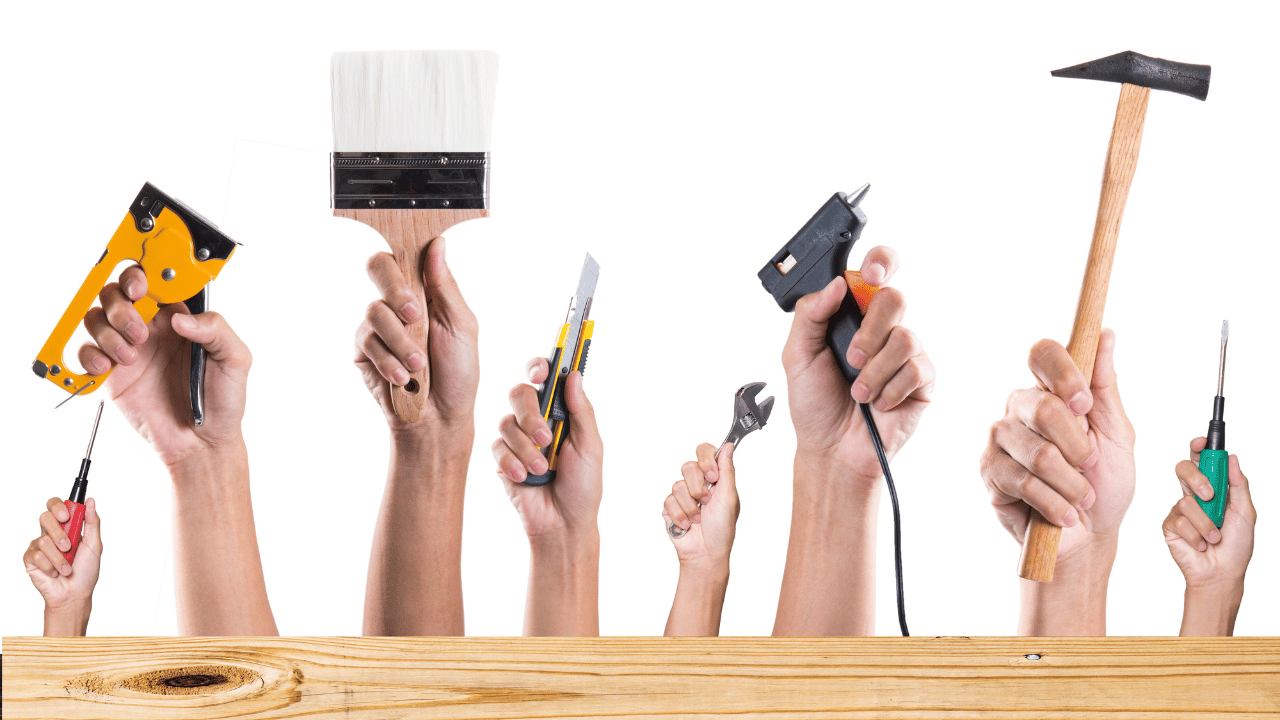Last Updated on September 7, 2023 by Pro Handyman Australia – Editorial Team
The Limits of DIY: Projects Best Left to Professionals
While embracing the spirit of DIY can be commendable and cost-effective for various home improvement projects, there are some tasks that might be best left to professionals. Even if countless hours of HGTV and endless YouTube tutorials have bolstered your confidence, some ventures require specialized knowledge, tools, and experience.
The Dangers of Overconfidence

It’s essential to recognize that not all home projects are created equal. Some tasks can become hazardous or costly if done incorrectly. Being well-informed and understanding when to seek expert help can not only ensure the safety and longevity of your home but also save you potential expenses and headaches in the future. Always assess the scope and risks before diving into any home improvement endeavor.
What you shouldn’t DIY?

The Challenge of Painting Kitchen Cabinets
While selecting the ideal shade might seem like the toughest decision when repainting kitchen cabinets, the process is more intricate than many anticipate. Often, kitchen cabinets have a buildup of cooking residue and oils. Preparing the cabinets involves meticulous cleaning with a solution such as diluted TSP. For the best finish, oil-based paint administered through a sprayer is recommended. Painting kitchen cabinets requires a different level of expertise compared to painting regular furniture. Only a skilled painter can ensure a quick and flawless finish for your cabinets.
The Pitfalls of DIY Custom Jobs
When homeowners venture into custom DIY projects without adequate knowledge, they often miss the intricate details that professionals pay attention to. For instance, one might decide to craft their custom shower pan and curb. However, without the right technique, this can lead to issues like incorrect membrane installation. Such oversights can result in water leakage, damaging structures like the sub-floor and drywall. Fixing these errors could significantly increase costs. When it comes to intricate DIY projects, the advice is clear: If you’re uncertain about your skills, it’s best to hire a professional.
Navigating Plumbing Issues: The Case of Sink Pipes
A clogged sink might seem like a straightforward fix. But diving headfirst into the problem without the necessary expertise can be a mistake. Plumbing systems are intricate, and pipes can be particularly challenging to reassemble, especially when close to other plumbing structures like garbage disposals. Even if you pinpoint the issue to a specific location, like under the sink, without prior experience, it’s advisable to hire a professional plumber.
The Complications of Installing Dishwashers
While purchasing a new dishwasher might seem straightforward, its installation can be intricate. The process might require drilling holes for water lines, aligning water and electric conduits, and connecting water lines. Due to the complexities, especially with tasks like setting up water and drainage lines beneath the kitchen sink cabinet, it’s wise to rely on a professional.
Dealing with Low Water Pressure
Low water pressure can be a source of frustration in households. While some might think of it as a minor inconvenience, sometimes it signals more significant issues in the plumbing system. Simple solutions, like cleaning out the aerator, might work. However, if the problem persists, it could be due to more severe issues like a fractured pipe or eroded water line. In such cases, it’s essential to consult a plumbing professional.
Proceed with Caution: Wall Removal
While the allure of an open floor plan tempts many homeowners to knock down walls, caution is advised. Some walls play a vital role in supporting your home’s structure. Damaging a load-bearing wall can lead to severe consequences, such as ceilings collapsing, and can pose potential harm to the residents. However, tasks like removing wallpaper are simpler and can be managed without professional assistance.
Electrical Work: Tread Lightly
While minor electrical issues, such as changing a fuse or resetting a switch, might be within the comfort zone of many homeowners, tasks that involve direct interaction with wiring should be approached with caution. The dangers associated with electrical repairs are manifold: from the immediate threat of electrocution to the potential hazard of poorly done work resulting in fires later on. Thus, for anything more complex than changing a light bulb, it’s recommended to consult a licensed electrician. Safeguard your home and your well-being by avoiding DIY with electrical components.
Introducing new lighting fixtures might seem straightforward, but working with electricity poses numerous risks. If one isn’t cautious about turning off live power, they run the risk of electrical shocks. Moreover, incorrectly wired setups can lead to future issues, such as sparking outlets and overloaded power systems. Given the mix of low and high-voltage products available, the complexity of electrical work is heightened. Due to the associated safety and fire risks, it’s best to entrust electrical projects to professionals.
Roof Repairs: Look Before You Leap
A minor leak or a few missing shingles might make roof repairs seem like a DIY-friendly task. However, simple repairs can sometimes exacerbate underlying issues. Patching up a problem area can result in mismatched roofing materials, drawing more attention to the repair site. Roofs, when maintained well, should last decades, but amateur attempts can introduce new complications.
Roof repairs introduce several challenges and hazards. The immediate risk is the considerable height and often steep incline that can lead to dangerous falls. Beyond that, roofing isn’t always as straightforward as it appears. Inexperienced attempts can lead to wastage of materials and may not stand the test of time or weather. Even if the repair seems successful, one gusty day could undo all the hard work. Moreover, insurance companies might not cover damages resulting from DIY mistakes. It’s best to trust professionals when it comes to mending roofs.
The Complexities of Waterproofing
Waterproofing might sound like a weekend project, but it’s laden with challenges. In some cases, homeowners start the task, only to leave an excavated hole exposed, leading to more moisture accumulation or even collapses. Additionally, safety concerns arise in such projects, with potential risks of trench-related accidents.
Switching On Safety: GFCI Installations
The GFCI switch, typically found in moisture-prone areas like kitchens and bathrooms, is crucial for electrical safety. But with redesigns and updates in GFCI configurations, DIY installations can prove challenging. Errors during installation might lead to compromised safety features. Given the vital safety role these switches play and the heightened risk of electrical shocks, it’s recommended to leave their installation to licensed professionals.
Demolition: Not as Simple as It Seems
Demolition might seem straightforward, but it can be fraught with risks. Enthusiastic homeowners might inadvertently damage vital structures or encounter hidden electrical wires. Such mishaps not only add costs but can also set back the project timeline. It’s essential to approach demolition with caution, ensuring undamaged parts of the space remain intact.
Consider Your Neighbors
Home improvement projects shouldn’t come at the expense of neighborly relations. Some ambitious DIYers have inadvertently damaged neighboring properties, leading to strained relationships and legal complications. For instance, without verifying property boundaries, homeowners might encroach on their neighbor’s land. Such oversight can result in costly legal battles and the potential need to undo months of work. Before embarking on significant projects, understanding property lines and legal requirements can save time, money, and relationships.
The Intricacies of Garage Door Repairs
At first glance, a garage door may seem like a straightforward structure to repair. However, this isn’t a task to be undertaken with just any tools you might have on hand. Acquiring specialized tools for a one-time repair isn’t just uneconomical; it’s also impractical. More concerning is the potential for serious injury. Torsion springs, for instance, store tremendous energy. Should they snap, the consequences can be both violent and unpredictable. A multitude of things can go awry, from using incorrect parts to inadvertently causing the heavy garage door to fall. Prioritize safety and leave this task to professionals.
Tree Removal: More Than Just Chopping
Estimating the fall trajectory of a large tree requires knowledge and experience. An inaccurate prediction can result in significant property damage, or even worse, injuries. Seasoned professionals consider various factors, such as the tree’s height, weight, and foliage distribution, ensuring precision in where and how they cut. Even if the task seems minor, like removing a few branches, the risks associated with climbing and handling heavy equipment make it hazardous. Unless you’re trained in tree maintenance or lumber work, it’s advisable to leave tree removal to experts. They possess the skills and knowledge to handle these tasks safely and effectively.
The Nuances of Crown Molding
Crown molding is often perceived as a simple aesthetic addition to a room. Yet, while its purpose is to enhance the room’s appeal, installing it is anything but simple. A significant challenge is that walls, even in newly constructed homes, aren’t always perfectly straight. The imperfections in walls can make the installation of molding a meticulous task that demands precision. Professionals in this field employ specialized tools and methods like scribing to ensure a snug and seamless fit. If you’re tempted to look up “DIY crown molding”, consider whether you’re truly prepared to commit to the detailed work required.
Expertise in Tile Installation
Tiling is an art, particularly if you’re aiming for the beautiful and complex designs often seen in modern homes. Although it may seem straightforward, it requires keen attention to detail, especially given that not all surfaces are perfectly level. For a result that has clean lines and even spacing, especially in intricate designs, it’s recommended to rely on professionals. Otherwise, instead of admiration, you might find visitors pondering over the misaligned tiles.
The Intricacies of Plumbing
It might be tempting to try patching a broken pipe on your own, especially if you’re in a bind. However, amateur repairs often lead to recurrent issues. The complexity of plumbing repair arises from the need for specific tools tailored to the size, material, and angles of pipes. Even if you happen to have these tools, there’s a myriad of steps that can be overlooked due to lack of expertise. For instance, understanding which adhesive to use for different PVC types and knowing the appropriate curing time is vital.
Moreover, when it comes to sealing the fittings around a repair, the challenge amplifies. Soldering, a process that involves a propane torch, is not only intricate but also fraught with potential hazards. While certain quick fixes, like shark-bite fittings, might seem convenient and are occasionally recommended for temporary solutions, they aren’t known for their longevity. In the long run, it’s always wise to trust a seasoned plumber to ensure lasting solutions and to avoid potential leaks in the future.
The Cost of DIY Missteps

While the allure of DIY projects is undeniable, it’s crucial to recognize the potential pitfalls. General contractors often find themselves rectifying issues stemming from DIY endeavors that didn’t go as planned. The irony lies in the fact that, after investing both time and money into a DIY attempt, homeowners often end up incurring additional expenses to have professionals correct their mistakes.
The Limitations of Online Research
The internet offers a plethora of information on almost any topic, making it a favorite go-to for DIY enthusiasts. However, online research, while valuable, cannot replace hands-on experience and the expertise that comes with years of practice. Instead of solely relying on online tutorials or forums, consider seeking guidance from professionals in the field. Their insights and advice can be invaluable, preventing potential missteps and ensuring a smoother project execution.
Conclusion
While embarking on DIY projects can be both fulfilling and economical, it’s essential to be aware of one’s limitations and the risks involved. Sometimes, consulting with a professional before diving into a project can be the most cost-effective and efficient approach, ensuring the job is done right the first time.
